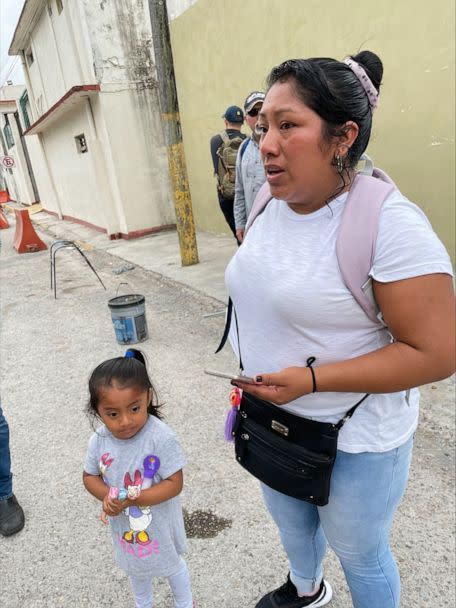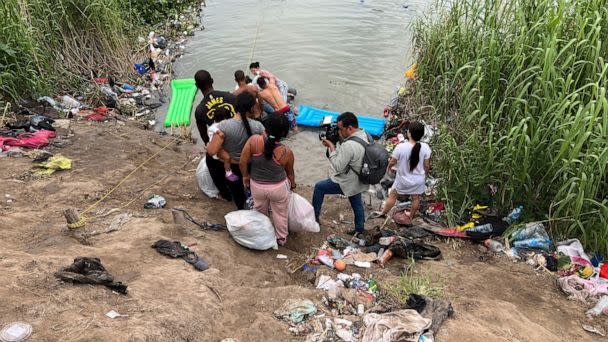Migrants desperate to live in US endure inhumane conditions near the Mexican border: Reporter's notebook
Most U.S. border towns, from Texas to California, thrive on a healthy relationship with their Mexican counterparts. Goods and labor flow back and forth, helping tourism and the economy on both sides. But in the last decade, those relationships have been strained and tensions have grown.
The Migrant Protection Program, or MPP, was created during the Trump administration. Thousands of migrants requesting asylum were sent back to Mexico to wait for their appointments or court hearings, resulting in the creation of a large-scale tent city in Matamoros, Mexico. The camp was only for migrant families and was fenced off to the general public -- even media couldn't get inside.
The migrants running the location set up a cooking area, a place to bath and use the restroom and even a play area for children. It was safe and orderly. Once MPP was discontinued, the camp was eventually shut down.
As the end of Title 42 creeps closer, a new camp has flourished in Matamoros. Over the last six months thousands have flocked to the Mexican border town, staging near the Rio Grande River and preparing to cross when the time is right. We traveled over the International Bridge into Matamorros, Mexico, with Pastor Abraham Barberi, a local minister associated with One Mission Ministries.
Title 42 is a Trump-era policy implemented during the pandemic that allows border patrol agents to expel migrants without allowing them to seek asylum but it does not come with consequences.
"At times, it's overwhelming. And I've wanted to quit. It's been going on too long and it's just difficult," he said. "I wake up in the morning many times and I think ... I'm done. I'm tired. It's not just that ... it's just feeling like you can't do anything."
MORE: US, Mexico reach migration deal as Title 42 deadline nears
And yet, several times a week he's in the camp delivering food or water and ministering to people. Within minutes we run into a young mother, Lucia Gomez, and her 2-year old daughter from Venezuela.
The pair have been living in the make-shift camp along the river for more than five months. Tears running down her face, Gomez tells us in Spanish that the CBPOne app went live at 10 a.m. with daily appointment slots but they were already all gone. It's 10:01 a.m.

We soon found out that level of desperation and anxiety has seeped into every corner of the camp that holds thousands of migrants in Matamorros. Families are sleeping in make-shift tents made of old blankets and broken tree limbs. They are cooking over open fire pits, with portable toilets and piles of trash feet away. It's primitive. It's dirty and inhumane. And yet, most of the people we spoke with say they are willing to endure this for a chance to get into the U.S.
But many are growing restless. They tell us the U.S. government's CBPOne app is meant for iPhone users and is difficult to navigate. Internet service is scarce and the cartel is now charging migrants for printouts of the instruction manual for the application process because the link is not readily accessible. Our camera caught a family with three young children, one in a body cast, crossing the river with pool rafts and a rope. Troops on the U.S. side watch it all go down without saying a word.

The family we saw crossing the river will end up in Brownsville at the city's newly erected processing facility along the river. On average the city is getting well over 2,000 migrants a day. Some will get sent back to Mexico by using Title 42; many will be processed and released. The city and local NGOs will help them find transportation out of the Rio Grande Valley. A majority will be staying with sponsors already here in the U.S.
Brownsville Mayor Trey Mendez told us: "We are ready. We know there are more people coming and these last few weeks have been a dry run for us."
When the Biden administration announced last April that they'd let Title 42 expire in May, migrants were required to apply for legal entry through a phone app and set up an appointment.
Title 42 ends on May 11 and officials continue to tell us they have no idea how many people to expect. They are confident they measures they've put in place so far will help them mitigate whatever comes their way.
Not everyone is convinced.
Pastor Abraham worries the situation will only get worse.
"No. I don't think we are prepared," Abraham said. "More asylum seekers are going to come and this is just going to get bigger.
Migrants desperate to live in US endure inhumane conditions near the Mexican border: Reporter's notebook originally appeared on abcnews.go.com

